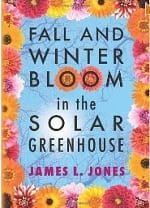James L. Jones, May 29, 2012
Reviewed by Tricia Diggins
Join an ELA Eco-tour of James Jones’s solar greenhouse on April 10, 2013.
It is hard for me to categorize James Jones’s new book Fall and Winter Bloom in the Solar Greenhouse. It is basically a gardening book as opposed to a book about ecological landscaping. By a gardening book I mean a book that is geared toward people who love to collect and grow plants for any number of reasons. Ecological landscaping books generally focus on methods and plantings that will enhance the local and global environment, but since many ecological landscapers love to garden and work with plants I would recommend this book for anyone thinking of building a “sunhouse” or who has a winter sun space.
When I think of solar greenhouses I think of the practical value they have for food growing, e.g. for season extension of vegetable crops or growing less than hardy fruiting plants. The content of Fall and Winter Bloom in the Solar Greenhouse is mostly in the realm of ornamental gardening. The book discusses possible plant choices for fall and winter bloom, offers hints on growing them, and adds the criterion that the plants must also take the lower temperatures (down to 32 degrees F) of an unheated greenhouse attached to a heated home. The popularity of the Boston Flower Show from March 13-17th is always a reminder of how desperately many people are waiting for spring and need a flower fix before spring arrives. It is a worthwhile ecological goal to satisfy the desire for color and vibrancy during the long winter without using an energy source other than the sun. The other major point the book makes is that the lower temperature of the solar greenhouse greatly decreases insect problems on plants so the need for insect control and pesticides is minimized.
I wish the book had an index because even though the plants discussed are listed alphabetically it would be a help to look at a condensed list for reference. A photo with each plant and better captioning of the pictures that are there would also improve the book. The plants discussed are probably unfamiliar to most gardeners, and it makes it difficult for a gardener to choose which plants they would like to seek out if they don’t have a good photograph. And as for seeking out plants, a list of seed, bulb and plant suppliers would have been very helpful.
If the article my boss has posted outside her office door, “Backyard Greenhouses: The New Woman Cave?” from the Wall Street Journal (March 7, 2012), is correct, there is certainly a niche for this book. The plants the author is growing require some gardening skills, but the novice can begin to learn these skills by studying the brief descriptions of plant ranges and habitats that Jones provides for each plant. Thinking of plants in relation to their native environments is at the foundation of ecological landscaping. I’m sure we all wish we had the time to create a lovely winter space such as the one Jones has created, but even if we don’t his book is a good source for dreaming, along with the seed catalogs, during the rest of this winter or next.
About the Reviewer
Tricia Diggins is the Senior Gardens Horticulturalist at Wellesley College where she has taken care of the Arboretum/Botanic Garden for nearly 23 years. She began her horticulture career as an intern at New England Wildflower Society’s Garden in the Woods in 1990 several years after earning a B.S. in Environmental Sciences at UMass Amherst. When Tricia isn’t caring for the plants at Wellesley College, she is developing and maintaining a third of an acre edible landscape. Tricia may be reached at pdiggins@wellesley.edu.


